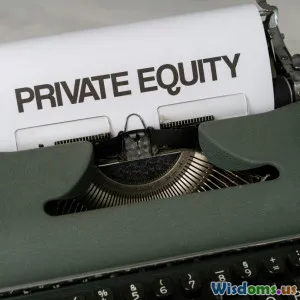
Top Mistakes to Avoid When Raising Startup Funding
14 min read Learn the top mistakes to avoid when raising startup funding to boost your chances of investment success. (0 Reviews)
Top Mistakes to Avoid When Raising Startup Funding
Securing capital is a defining journey for every startup. For founders, pitching to investors may be both exhilarating and daunting, and getting it right can set their company on a path to success. However, raising startup funding is riddled with potential pitfalls—missteps that can cost more than just dollars.
Understanding the landscape, learning from others' mistakes, and making informed choices can mean the difference between a game-changing financial partnership and a cautionary tale. Here are the most critical mistakes founders should avoid, and how to navigate the fundraising maze with clarity and confidence.
Rushing Into Fundraising Too Soon

One of the most frequent mistakes is seeking investment before the startup is truly ready. Many founders feel pressure to secure outside funding ASAP, but premature fundraising can lead to underwhelming results or diluted ownership.
What does 'too soon' look like?
- Unproven Idea: Pitching with nothing but a concept and no demonstrable traction
- Unclear Business Model: Not having clarity on how the company will make money
- No MVP or Prototype: Lacking a functional minimum viable product to show progress and product-market fit
Example: Gobble Food, an early meal kit startup, initially struggled when pitching with only idea-stage decks and no defined customer base. The result: low investor interest and low confidence.
How to Avoid:
- Develop an MVP and gather user feedback or early revenue before your first fundraising round
- Use bootstrapping or small grants (e.g., from accelerators like Y Combinator or Techstars) to reach early milestones
- Refine your business model so you can clearly show how investment will accelerate product-market fit
Ignoring Investor Fit

Not all investors are a match for your venture. Chasing any funding, regardless of source or alignment, is a recipe for friction down the line.
What is 'investor fit'?
- Stage and Sector Alignment: Does the VC or angel invest in startups at your stage (pre-seed? Series A?) and industry?
- Value Alignment: Do they share your values and vision, especially on exits, scale, and mission?
- Engagement Style: Hands-on investors may want input on strategy, while others give space. Which suits you?
Example: Snapdeal, an Indian online marketplace, experienced conflict after bringing on board investors without shared strategic vision, eventually leading to a pivot that diluted its original goals.
Tips:
- Research investors thoroughly—check their portfolios, past deals, and engagement with founders
- Ask for references from portfolio companies
- Have upfront discussions about expectations and decision rights
Underestimating the Importance of Due Diligence

Some founders focus solely on winning a term sheet, neglecting the thorough review and negotiation needed. This can result in unfavorable terms that handicap future rounds or founder autonomy.
Key Due Diligence Blind Spots:
- Skipping Legal Review: Not seeking legal counsel to review term sheets, equity splits, and board rights
- Misunderstanding Convertible Notes or SAFEs: Overlooking conversion mechanics, discount rates, and caps
- Ignoring Future Dilution Impacts: Not modeling how multiple rounds will erode founder ownership
Example: Early Foursquare investors got a highly favorable liquidation preference and control clauses, only revealed as problematic in later funding rounds.
Advice:
- Hire experienced startup lawyers familiar with venture terms
- Use free resources like YC's SAFE templates and sample dilution calculators
- Model out different funding scenarios before you negotiate
Overoptimistic Valuations

Many founders, hoping to minimize dilution, price their startups unrealistically high. While this can work in overheated markets, it usually sets up future disappointments.
Why Is Overvaluation Dangerous?
- Down Rounds: If metrics don't keep pace, future funding may require a lower valuation, causing loss of morale and credibility
- Difficult Exits: Acquirers may balk at high investor expectations
- Extra Pressure: Investors may push for unsustainable growth to justify high valuation
Example: WeWork, valued at $47B in 2019, had a public collapse after failure to meet performance matched to valuation hype.
Guidelines:
- Use signposts: comparable company valuations, revenue multiples, and recent deals
- Be realistic about growth projections and market size
- Remember: The best investors value collaboration over lofty promises
Focusing Only on Money, Not Strategic Value

The right investors bring much more than just dollars—they offer industry connections, operational guidance, and credibility. Failing to recognize the strategic partnership component can be costly.
Takeaway:
- Strategic Investors: May open doors to major customers or future acquirers
- Smart Money > Fast Money: Willingness to wait for the right investor can deliver long-term upside
Example: WhatsApp chose Sequoia Capital, whose network and discretion yielded marketing and scaling support that far outweighed the check size—culminating in a $19 billion Facebook acquisition.
Best Practice:
- Evaluate what else an investor provides: intros, reputation, sector knowledge
- Ask about their past post-investment involvement
Lack of Transparent, Data-Driven Storytelling

A common fundraising blunder is failing to convey your story through credible, transparent data. Vague or exaggerated claims are easy for investors to spot, eroding trust instantly.
What Makes Compelling Data Storytelling?
- Understanding Metrics: Know your key KPIs—CAC, LTV, churn, retention, runway
- Evidence-Backed Milestones: Show traction: users, revenue, engagement with credible, up-to-date numbers
- Clarity on Challenges: Be honest about hurdles; share plans to address them
Example: AirBnB faced initial VC skepticism until they produced explicit, granular data showing growth post-Y Combinator. Transparency—and quick clarification of tough questions—won over investors.
How To Improve:
- Regularly update your data room with customer, financial, and product analytics
- Use data visualizations (charts, tables, dashboards) in your deck
- Prepare to answer deep-dive investor follow-ups
Neglecting Preparation for Investor Meetings

The quality of your investor interactions can make or break a round. Being underprepared for meetings is an unforgivable error.
Key Ways Founders Fall Short:
- Weak Pitch Decks: Slides are unclear, cluttered, or generic
- Shallow Responses: Inability to explain core metrics or competitive positioning
- Not Knowing The Investors: No awareness of their recent investments or interests
Example: In "Shark Tank," entrepreneurs who could instantly cite market size and customer acquisition cost invariably earned more interest from sharks (and at better valuations).
Preparation Tips:
- Customize your narrative to each investor's interests
- Run mock Q&A sessions with mentors or advisors
- Memorize key figures and backstories; don't just read off slides
Weak Cap Table Management

Ongoing, careless equity allocation can cripple your company’s ability to attract investment later on.
What Goes Wrong?
- Over-Diluting Early: Giving too much away to advisors, service providers, or friends
- Messy Records: Incomplete, incorrect, or outdated capitalization tables
- Lack of Employee Stock Pool: Not setting aside options for key hires creates friction
Example: TechCrunch reported a gaming startup whose cap table featured dozens of early, small contributors with non-standard terms—complicating later VC rounds and acquisition talks.
Action Items:
- Use cap table management tools (Carta, Pulley, LTSE Equity)
- Establish clear option pools and vesting so you can recruit top talent
- Get legal help to clean up any past mistakes before your first VC meeting
Not Nurturing Investor Relationships for the Long Term

Many founders see fundraising as a transaction rather than the start of a relationship. This attitude can alienate valuable allies down the line.
The Reality:
- Your first conversation is rarely your last; build trust and open communication from Day One
- Seasoned investors appreciate (and remember) professionalism, candor, and gratitude
- Even a 'no' today can become a 'yes' later as your company matures
Example: The founders of Stripe, Patrick and John Collison, kept detailed notes on every investor pitch, circling back after milestones; many early rejections turned into leading late-stage backers.
How To Build Relationships:
- Send honest, regular company updates to potential and current investors
- Share wins and setbacks to create a trusted dialogue
- Continually ask for feedback, even from those who pass
Failing to Plan for the Next Round

Treating each raise as a one-off event is a common stumbling block. Failing to anticipate future funding needs can trap startups between deadlines and unpreparedness.
Why It Matters:
- Funding processes can take 6+ months; running out of cash limits negotiation power
- Sophisticated investors want to see plans for the next 12–24 months
Example: A 2022 CB Insights report revealed that 38% of failed startups ran out of cash, often blindsided by unforeseen burn rates or delayed revenues.
Smarter Approach:
- Build multiple runway scenarios—optimistic, base, and downside
- Track KPIs that matter most for your next stage (MRR, DAU, CAC)
- Map out when you’ll need to start the next round—and backward-plan milestones
Overlooking the Power of Founder Networks

Founders often underestimate the importance of engaging their professional networks for introductions, advice, and warm leads.
Network Effects:
- Well-connected founders can access tier-1 investors sooner
- Fellow entrepreneur references carry significant weight
Example: Female founders with strong community ties, such as through All Raise or Women Who Tech, report higher match rates for networked introductions vs. cold applications.
To Leverage Your Network:
- Attend industry events and pitch competitions
- Seek mentors with fundraising experience
- Offer value to others; the law of reciprocity pays off
Navigating startup funding is challenging, but awareness and strategic preparation can sidestep critical errors. Prioritize timing, compatibility, transparent metrics, and cultivation of lasting partnerships. Learning these lessons up front empowers your startup—no matter your stage—to approach every round with confidence, discipline, and resilience.
Rate the Post
User Reviews
Popular Posts
















